Meeples & Monsters is worker placement and bag-building lite, but is it a de-light?
Recently fulfilled via Kickstarter and at retail during 2022, Meeples & Monsters has an awful lot going for it. Designer Ole Steiness has a lot of credit in the bank thanks to the excellence of Champions of Midgard, and publisher AEG is well known for producing gorgeous games. What’s more, there’s a distinctly Lords of Waterdeep feel to Meeples & Monsters that makes it easy to get into.
Meeples & Monsters really doubles down on the meeple aspect of its title. Meeples are not only the main component of the game, but they are also represented on the character and monster cards in such a way that the meeple city of Rowan in which the game takes place is brought to life really nicely. Bold lines, big spaces and strong graphics make Meeples & Monsters genuinely stand out when set up.

The board is perhaps a bit bigger than it needs to be, and it’s certainly true that each of the player boards (depicting different taverns in the city) is far larger than necessary, with lots of non-functional space. Nonetheless, the overall effect is nothing short of impressive. During setup, each player will also be handed an equally oversized (and beautifully embroidered) bag into which their meeples will be placed.
Meeples then. This game has tons of them. The Kickstarter edition even has silk-printed artwork on its meeples which makes them look very cool, but the retail edition (which is the one I am reviewing) does not. Still, there are grey, white, blue, red, yellow, green, black, orange and purple meeples each of which represent different kinds of character — peasants, knights, warriors, paladins, rangers and so on are all represented, whilst the grey meeples are simply “corruption” which is almost always useless.

Functionally, these meeples feel suspiciously similar to the cubes used in Lords of Waterdeep, and another similarity between the two games is that in Meeples & Monsters a common action during the Development Phase is to choose one of four building tiles and to place it on the board, adding a worker placement space that can be used later (including in the next phase of the same turn).
During the Action Phase, players can place meeples from the “ready” area of their tavern onto the board. At the start of the game, they will be given seven white peasant meeples and three grey corruption, and four of these will be drawn from the bag to place in the tavern. Grey meeples don’t do anything really (especially not on the first few turns) but white meeples can be used to build (during the Development Phase described above), activate certain buildings or to attack monsters.
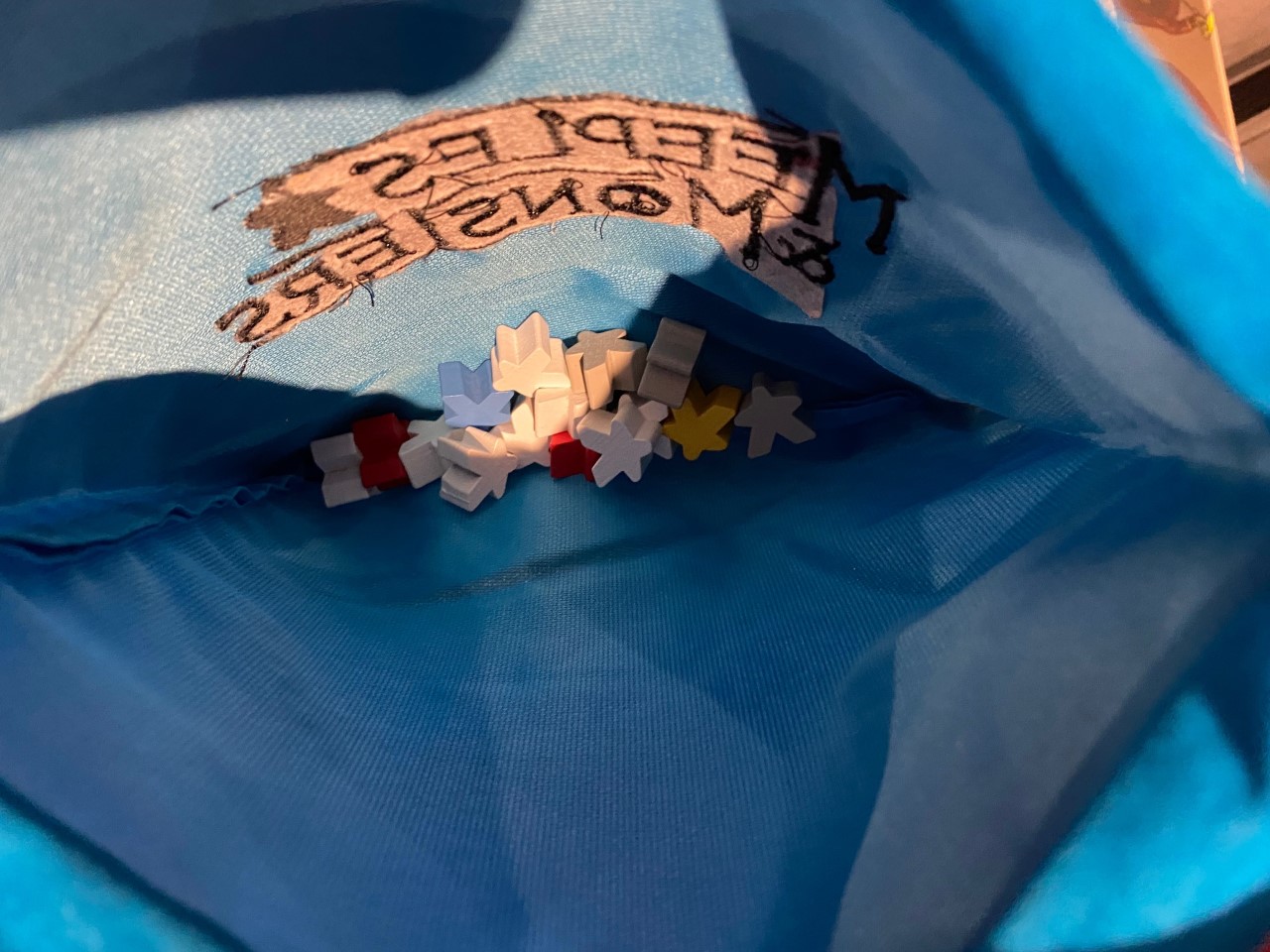
On the first turn or two, players will only see at most four white meeples, but some combination of peasants and corruption is more likely, so early turns focus on building (which often allows a player to draw a coloured meeple from the building placement) or on using buildings to either upgrade or obtain coloured meeples. When a coloured meeple joins a player tavern, it goes directly to the “resting” area of the player mat. Similarly, all meeples placed on the board during a player turn also go to the rest area — and the player then draws four more meeples (re-bagging the meeples in the rest area if they ever need to draw meeples and their bag is empty).
And so the game flows with players placing their meeples, sometimes adding a building to the board, drawing meeples and adding them to their tavern and occasionally doing the more interesting actions in Meeples & Monsters. These include upgrading meeples, attacking monsters or drawing and perhaps completing quest cards. Without getting into too much detail, let me talk you through those actions now.
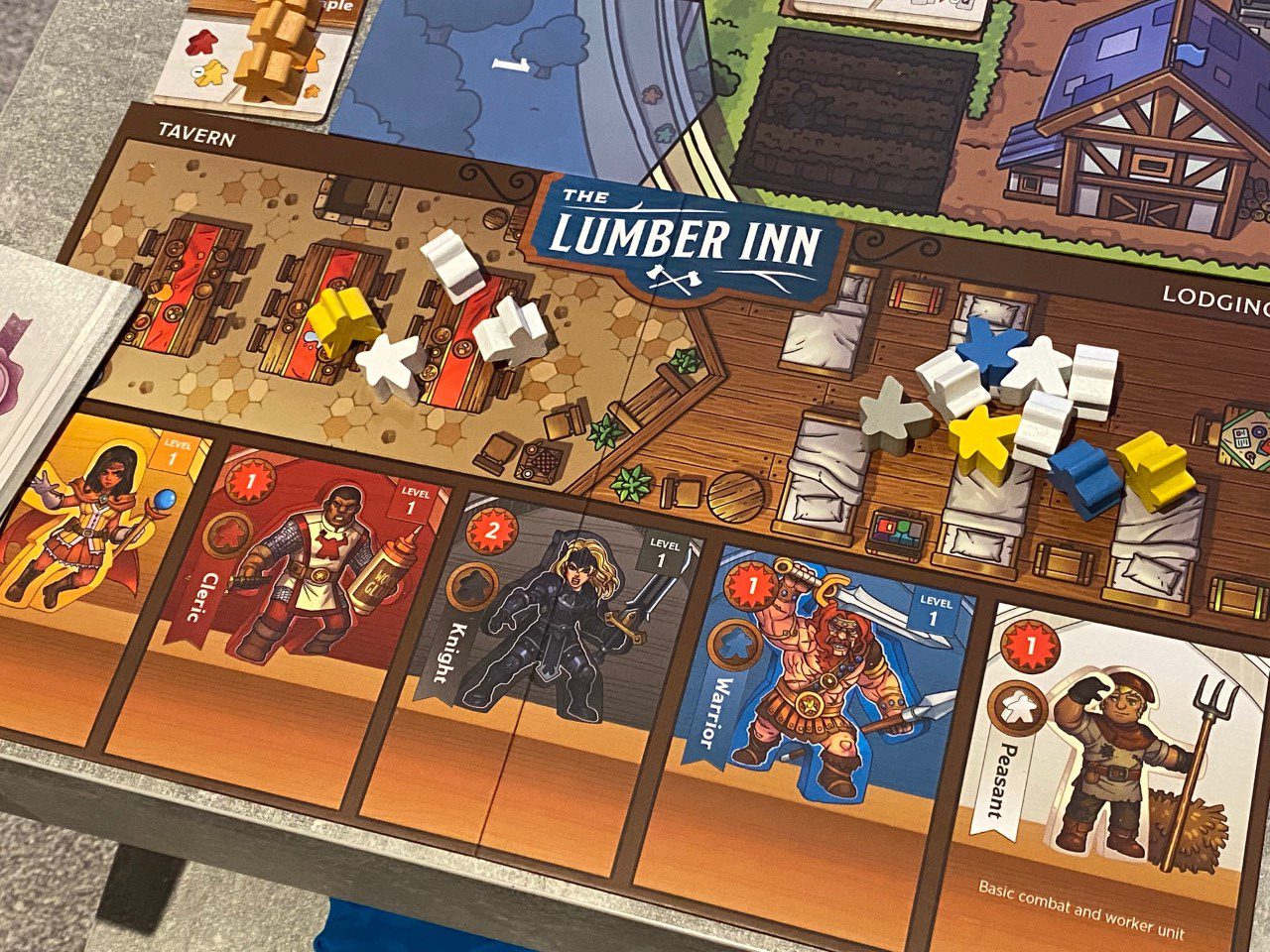
Attacking monsters is quite straightforward. There will always be six monsters available to fight (until the endgame, which I’ll cover later) spread between the four areas of the board based on symbols showing on them. Each monster has a health value, a points value, a level (from one to three) and occasionally text and/or an additional benefit when defeated. All a player needs to do to defeat a monster is to place meeples on it during the Action phase with a strength equal to the monsters total health — for example, a monster with three health will require three basic meeples of any colour (each dealing one damage) or a combination of basic and upgraded meeples (which might do more than one damage) to equal three.
If a player can defeat the monster in this way, they will take the monster card and add it to their supply, gaining the points shown immediately, as well as any other benefits shown — which might include a meeple or two of specific colours, or a new quest card. Seeing as I am discussing quests, I will just mention that some quests ask players to defeat monsters from certain types — undead or humanoid for example — and this plays a factor into which monsters you’ll want to attack.
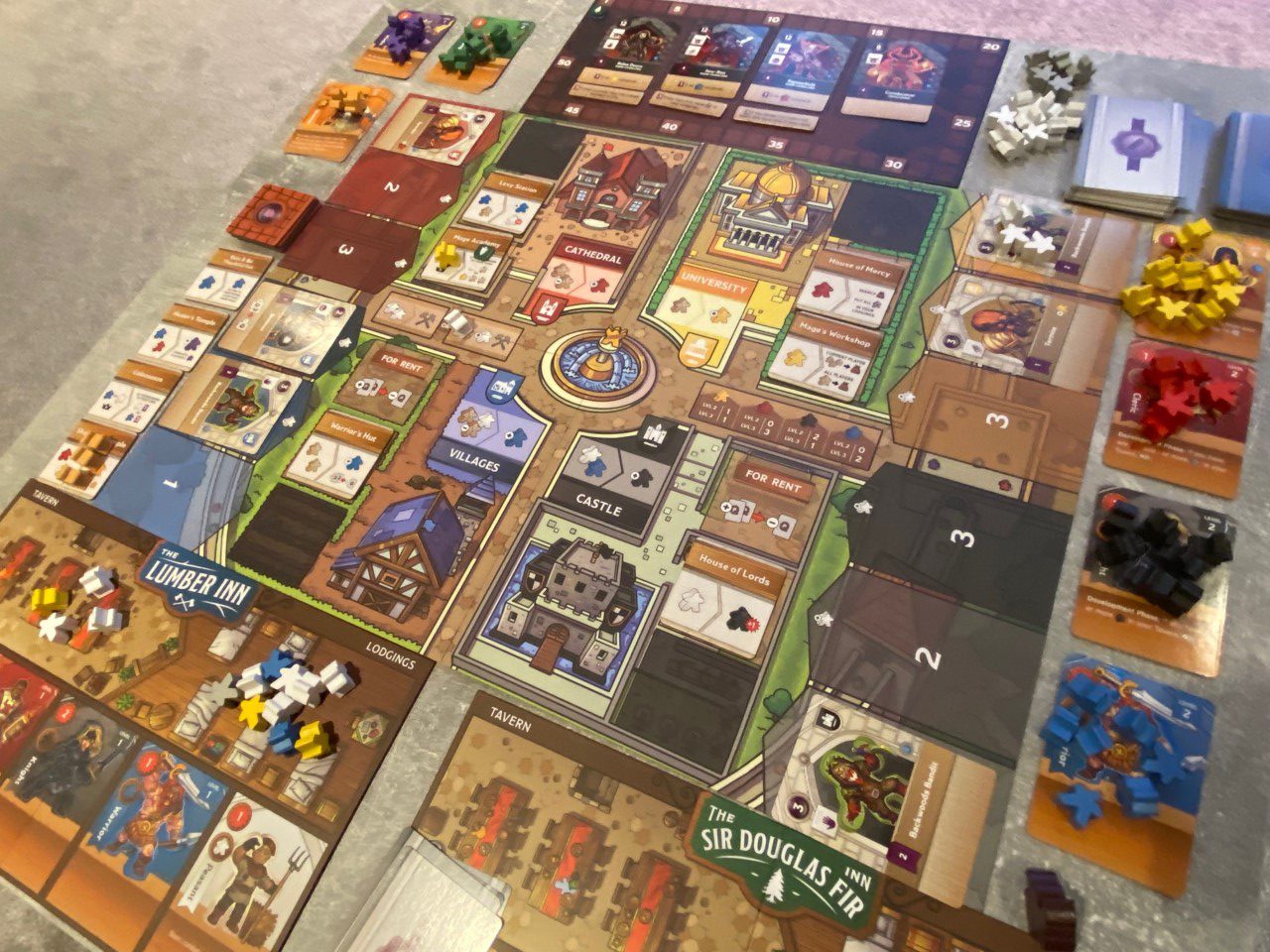
As a minor point, monsters can overrun districts in the city when that district is used for purposes other than fighting a monster, but the consequence is only that the player using the district is forced to add a peasant to their bag — which can actually be helpful in the very early game. This doesn’t happen if a player chooses to use that district and fight a monster there, because thematically the white meeple (which is a fleeing peasant) doesn’t have to flee as a consequence of the monster being killed.
Upgrading meeples is perhaps the most interesting bit of Meeples & Monsters, and bearing in mind that Ole Steiness’s other major hit (Champions of Midgard) was all about using dice as warriors, I can see a similarity in thought process here. In short, basic meeples like warriors, knights, mages and clerics can all level up twice — allowing the player to cover the matching space on their tavern with the level of card they have upgraded too, and then enjoying the benefits — which can be via combat strength or additional text — from then on.
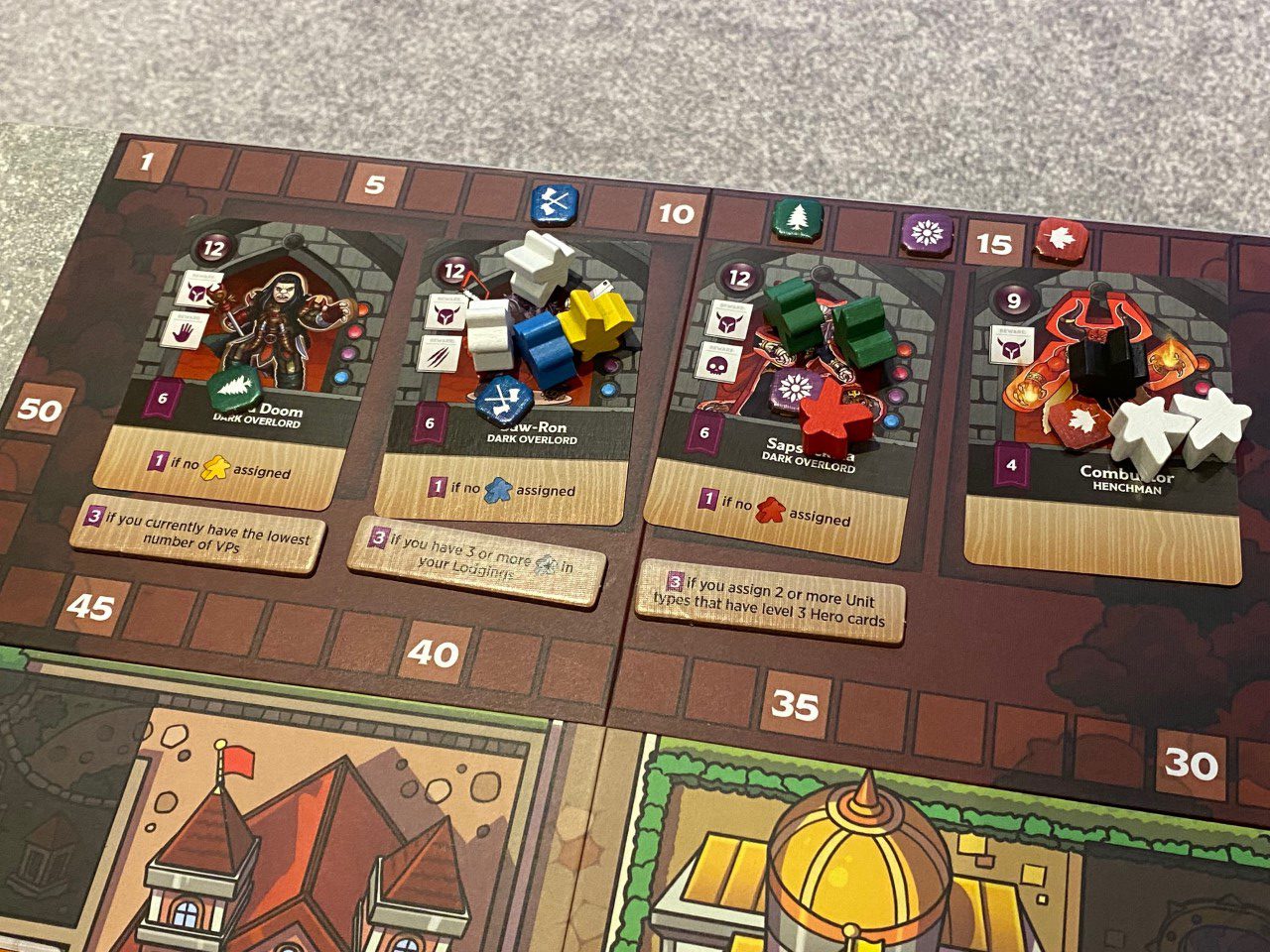
This really enhances the bag-building focus, because now you are not only interested in the quality of meeples in your bag (corruption worst, peasants bad, basic meeples better, prestige meeples best) but also the kind. It is fairly valid to have a decent spread of “mildy upgraded” meeples with a few prestige meeples, but it’s also just as good to focus on a couple of the different meeple colours and upgrade them right to level three if you can. This choice is often dictated by your starting quests and those you gain throughout the game, and being able to draw two and discard one (in terms of quest cards) is a massive and frequently used mechanic in Meeples & Monsters.
At several points in the game “Dark Council” cards will appear in the monster deck. Whenever this happens, the players will begin drawing an additional meeple each turn (five, then six) until the third Dark Council card arrives and signals the endgame. From this point on, the players will each have two turns in which to attack the Dark Council members to maximise their points total — and ultimately the winner of Meeples & Monsters is the player with the most points on the board and on any quest cards that count at the end of the game.
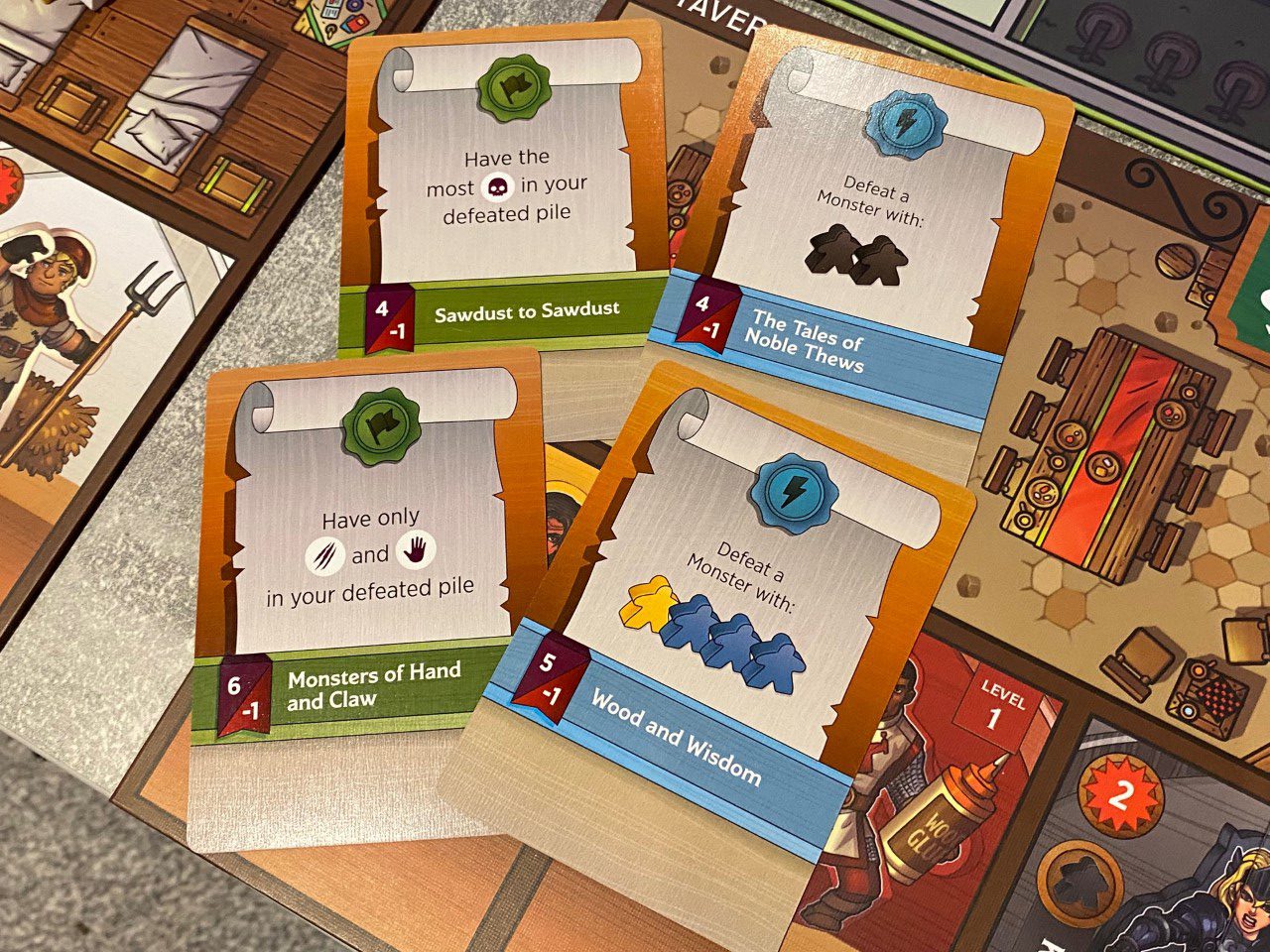
Meeples & Monsters is dead simple and it really will feel familiar to any fan of either Champions of Midgard or Lords of Waterdeep. What it does well is introduce players to its mechanics slowly and surely before layering in more to remember — upgrades to specific meeples or unique bonuses that align to specific defeated monsters or completed quests. It’s all very pleasant and generally undemanding at the start, but by the endgame Meeples & Monsters can become fiercely competitive.
Where I think there is a slight downside with Meeples & Monsters is in what comes in the box. There are 15 building tiles (which feels a bit sparse when you see how much space is left for future expansions) and there is already a mini-expansion that introduces Towers (and has dedicated board space which is unused in the base game) available as an extra. It’s also a shame that the screen-printed meeples are absent from the retail version, although this makes a bit more sense considering the price point.

Overall, Meeples & Monsters gave me a great experience over the course of about four or five games, each of which was brief and tightly contested. The only issue I can foresee is that we’ve already seen every building and fought every monster several times. There is no variety in the Dark Council (which is always the same four enemies) and I just feel like a few more ways to twist and turn the experience in the core box would have been nice.
You know what they say; “you can’t have too much of a good thing” and that’s true here. The fact is, Meeples & Monsters is a good thing. It’s a beautiful, enjoyable game and it’s a lot of fun for a broad range of players, including older and younger, or more experienced or brand new. Definitely one to look into seriously if the theme or visuals appeal to you in any way.
You can purchase Meeples & Monsters on Amazon.
Love board games? Check out our list of the top board games we’ve reviewed.
Comments are closed.